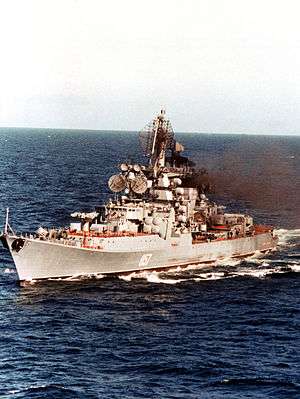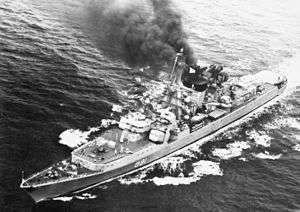Kresta II-class cruiser
The Kresta II class, Soviet designation Project 1134A Berkut A (golden eagle), was a class of guided missile cruiser (large anti-submarine warfare ship in Soviet classification) built by the Soviet Union for the Soviet Navy. The NATO lists the class as "cruisers" mainly due to the Metel (SS-N-14 Silex) anti-ship missile system capable to strike not only submarines but also surface vessels.
 Kresta II-class cruiser Admiral Yumashev. | |
| Class overview | |
|---|---|
| Name: | Kresta II class |
| Builders: | Zhdanov Shipyard |
| Operators: | |
| Preceded by: | Kresta I class |
| Succeeded by: | Kara class |
| Built: | 1966–1977 |
| In commission: | 1969–1993 |
| Completed: | 10 |
| Retired: | 10 |
| General characteristics | |
| Type: | Guided missile cruiser |
| Displacement: |
|
| Length: | 159 m (522 ft) |
| Beam: | 17 m (56 ft) |
| Draught: | 6 m (20 ft) |
| Propulsion: |
|
| Speed: | 34 kn (63 km/h; 39 mph) |
| Range: |
|
| Endurance: | 1830 tons fuel oil |
| Complement: | 380 |
| Sensors and processing systems: | Radar; Don Kay, Don-2, Top Sail, Head Net 2 x Head Lights 2 x Muff Cob, 2 x Bass Tilt, Sonar; Bull Nose |
| Armament: |
|
| Aircraft carried: | 1 × Ka-25 series helicopter |
| Aviation facilities: | Helipad and hangar |
Design
The Kresta II class was an anti-submarine derivative of the Kresta I-class cruiser, and were armed with a new anti-submarine missile (SS-N-14), new surface-to-air missiles (SA-N-3) and advanced sonar. Conway's states that the first three ships were to have been armed with the SS-N-9 anti-ship missile but Soviet naval doctrine changed with greater emphasis on anti-submarine warfare. The surface-to-air missiles comprised more advanced SA-N-3 missiles with two twin launchers. New 3D search radar and new fire control radars were also fitted. 4 30mm CIWS guns were also fitted for improved anti-missile defence. A more advanced sonar led to the bow being more sharply raked. The machinery suite comprised two TV-12 steam turbines with high-pressure boilers, identical to the Kresta I class.
General characteristics
The Kresta II-class cruisers were 158.5 metres (520 ft) long with a beam of 16.9 m (55 ft) and a draught of 6 m (20 ft). They displaced 6000 tons standard and 7800 full load. They had a complement of 380-400 and were equipped with a hangar aft to stow away a Kamov Ka-25 Hormone-A helicopter.[1]
Kresta II-class vessels were propelled by two TV-12 steam geared turbines powered by four high pressure boilers which created 75,000 kilowatts (101,000 hp).[1] This gave the cruisers a maximum speed of 34 knots (63 km/h; 39 mph).[1] They had a range of 10,500 nautical miles (19,400 km; 12,100 mi) at 14 knots (26 km/h; 16 mph) and 5,200 nmi (9,600 km; 6,000 mi) at 18 kn (33 km/h; 21 mph).
Armament
For their primary role as anti-submarine cruisers, the Kresta II class mounted two quadruple launchers for eight SS-N-14 anti-submarine missiles. They were also equipped with two RBU 6000 12-barrel and two RBU 1000 6-barrel rocket launchers.[1] The Ka-25 helicopter embarked on the cruiser was also capable of aiding in the search and destruction of submarines.
Against aerial threats the cruisers were armed with four 57mm L/80 DP guns situated in two twin mountings. They also had four 30mm AK-630 CIWS mountings. They were armed with two twin launchers for the 48 SA-N-3 surface-to-air missiles they carried.[1]
The ships also mounted two quintuple mountings for 533 mm (21.0 in) dual-role torpedoes.[1]
Sensors
The Kresta II class were equipped with MR600 air search radar MR-310 Angara Don navigational and Volga navigational radars. For anti-submarine warfare they had MG-322 hull mounted sonar. For fire control purposes they had Grom SA-N-1 fire control, MR103 AK725 fire control and Drakon RP33 fire control. They also had a MG-26 communications outfit and a MG-35 Shtil.
The first four ships of the class to be completed were not equipped with the MR-123 Vympel fire control radar for the AK-630, and relied on manual targeting instead.[2]
Ships
All the ships were built by the Zhdanov Shipyard in Leningrad.

| Name[3] | Russian | Namesake | Laid down | Launched | Commissioned | Decommissioned |
|---|---|---|---|---|---|---|
| Kronstadt | Кронштадт | City of Kronstadt | 30 November 1966 | 10 February 1968 | 29 December 1969 | 24 June 1991 |
| Admiral Isakov | Адмирал Исаков | Ivan Isakov | 15 January 1968 | 22 November 1968 | 28 December 1970 | 30 June 1993 |
| Admiral Nakhimov | Адмирал Нахимов | Pavel Nakhimov | 15 January 1968 | 15 April 1969 | 29 November 1971 | 31 January 1991 |
| Admiral Makarov | Адмирал Макаров | Stepan Makarov | 23 February 1969 | 22 November 1970 | 25 October 1972 | 3 July 1992 |
| Khabarovsk (ex-Marshal Voroshilov) |
Хаба́ровск (Маршал Ворошилов) |
City of Khabarovsk (Kliment Voroshilov) |
20 March 1970 | 8 October 1970 | 15 September 1973 | 3 July 1992 |
| Admiral Oktyabrsky | Адмирал Октябьский | Filipp Oktyabrskiy | 2 June 1969 | 21 May 1971 | 28 December 1973 | 30 June 1993 |
| Admiral Isachenkov | Адмирал Исаченков | Nikolai Isachenkov | 30 October 1970 | 28 March 1972 | 5 November 1974 | 3 July 1992 |
| Marshal Timoshenko | Маршал Тимошенко | Semyon Timoshenko | 2 November 1972 | 21 October 1973 | 25 November 1975 | 3 July 1992 |
| Vasily Chapaev | Василий Чапаев | Vasily Chapayev | 22 November 1973 | 28 November 1974 | 30 November 1976 | 30 June 1993 |
| Admiral Yumashev | Адмирал Юмашев | Ivan Yumashev | 17 April 1975 | 30 September 1977 | 30 December 1977 | 13 July 1992 |
Notes
- Chant, Christopher (2014). Compendium of Armaments and Military Hardware. Routledge. p. 196.
- Hampshire 2017, pp. 27–28.
- Averin 2007, p. 49.
References
- Averin, A.B. (2007). Адмиралы и маршалы. Корабли проектов 1134 и 1134А [Admirals and Marshals: Ships Project 1134 and 1134A] (in Russian). Moscow: Voennaya Kniga. ISBN 978-5-902863-16-8.CS1 maint: ref=harv (link)
- Gardiner, Robert (ed.) (1995). Conway's All the World's Fighting Ships 1947–1995. London: Conway Maritime. ISBN 0-85177-605-1. OCLC 34284130.CS1 maint: extra text: authors list (link) Also published as Gardiner, Robert; Chumbley, Stephen; Budzbon, Przemysław (1995). Conway's All the World's Fighting Ships 1947–1995. Annapolis, MD: Naval Institute Press. ISBN 1-55750-132-7. OCLC 34267261.
- Hampshire, Edward (2017). Soviet Cold War Guided Missile Cruisers. New Vanguard 242. Oxford: Osprey Publishing. ISBN 978-1-4728-1740-2.CS1 maint: ref=harv (link)
External links
- Kresta Class - Project 1134 at Federation of American Scientists website
- article in Russian
- [article in Russian]
- All Russian Kresta II Class Cruisers - Complete Ship List
| Wikimedia Commons has media related to Kronshtadt class cruiser. |